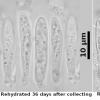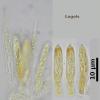
24-04-2024 21:54
Bonjour, J'ai trouvé ce Lasiobolus sur laissées

23-04-2024 15:18
 Lothar Krieglsteiner
Lothar Krieglsteiner
... but likely a basidiomycete. I hope it is o.k.

23-04-2024 13:17
 Edouard Evangelisti
Edouard Evangelisti
Bonjour à tous, Je viens de récolter ce que je

23-04-2024 21:49
Ethan CrensonHello all, A friend recently found this orange as

22-04-2024 11:52
 Zuzana Sochorová (Egertová)
Zuzana Sochorová (Egertová)
Hello,I made a loan of a collection of Microstoma

11-01-2022 16:36
Hi does anyone have a digital copy of Raitviir A (

22-04-2024 20:38
 Miguel Ángel Ribes
Miguel Ángel Ribes
Good afternoon.Does anyone know this anamorph?It g

19-04-2024 14:28
Cudoniella tenuispora: Distinctive macro and habit
 Hello..
Hello..This fungus was found on dead fallen leaves of either Vaccinium sp. or Guylaussacia sp. in a wet lakeside area in New Brunswick, Canada. The apothecia appear closed when they are dry and then open up when moistened. They seem to be still alive and to revive after being air-dried for 36 days but do not look as good after 50 days.
Very small, the ascospores are only 3.7-4.4 X 1.1-1.4 µm, D/d = 3.00-4.00. Paraphyses clearly lanceolate.
Is this a species of Venturiocystella? It is a first for me.
David

There are two species in my key that come into consideration: V. diversipila on leaves of Fagales, and V. venturioides on Vaccinium uliginosum leaves. Measurements are somewhat intermediate (see beow).
There is also a V. gaylussaciae on Gaylussacia leaves, but its spores are much larger.
The dark setae of your fungus look rather long, over 100 µm? Do you have a scale for the survey photo?
7. Asci †17-23 x 4.3-6 µ, apical ring very faintly ?blue in IKI, whole ascus wall faintly hemiamyloid (after KOH distinctly IKI-blue), setae c. 9-40 per apothecium, only inserted on flanks, basally lageniform, wall 0.5-1(-1.5) µm thick, light hairs only at margin, on leaves of Betula, Quercus, Populus, in autumn, Central Europe V. diversipila
7. Asci †26-46 x 4.3-6 µm, apical ring rather stongly blue in IKI, ascus wall IKI-, setae c. 80-120 per apothecium, hardly swollen near base, wall 1-3 µm thick, setae and light hairs occurring mixed on whole exterior, on leaves of Vaccinium uliginosum in early summer, Northern Europe V. venturioides
Zotto

Thank you for commenting on my collection. It is my first introduction to this interesting genus. It does indeed seem very close to V. venturioides. The ascomatal hairs on the collection in the photo measure about 175 µm long. I will go back and check this with another apothecium to see if that is correct.
Incidentally, the material that had been dried for 36 days was able to produce a spore print on agar. So, as you pointed out, at least some of the asci remained alive then.
David

For the dead asci I get from your scale (19-)21-24(-26) x 3.8-4.1 µm. So this is closer to diversipila.
There are very few sequences of the genus, virtually only for V. japonica.
If you get a culture, please consider also a sequence.
Zotto

Further work may have to wait until next June when the fungus is fruiting. It seems to be very abundant on its substrate and in that locality.










